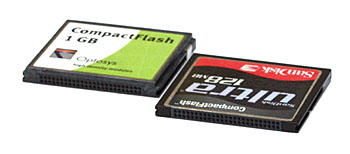Digital Photography Now Peripheral Reviews | |||
Compact Flash card mini group test | |||
By Ian Burley | |||
We compare CF cards from Dane-Elec, SanDisk and Optosys and discover they are very different performers.Go to test result data and charts - click here Whatís special about these cards? The Optosys card packs a whopping 1GB of capacity in its Type II form factor. Itís not an IBM microdrive clone, but a solid state card that stacks flash memory dies in several layers. The Dan-Elec card is fairly routine device Type I, priced competitively and offering a capacity of 256MB (512MB version pictured). Finally, we have a 128MB SanDisk Ultra card, also a Type I device, aimed specifically at owners of digital cameras that produce large image files. SanDisk Ultra cards have a revised controller to accelerate data rates when writing to the card.
How we testedAll performance testing was carried out using a Jenoptik Jenreader Firewire compact flash card reader (click here to see our review), connected to an Adaptec PCI Firewire card installed in a 1.4GHz Athlon PC running 512MB PC2100 DDR RAM and Microsoft Windows XP Professional. The PC is fitted with 7200RPM IBM ATA100 hard disk drives. This arrangement ensures that there is no bandwidth bottleneck in the card reader and its connection to the host PC. All timings were done independently of any data buffering. We timed read and write performance using two sets of files. Set 1 is a 63MB folder containing just 9 high resolution JPEG images. This represents files typical of a 5 megapixel digital camera. 1 Set 2 is a 30MB folder containing nearly 800 small files. This set tests the efficiency of the cardís controller to deal with many small file operations. The resultsItís tempting to think that all compact flash cards are much the same, performance-wise. The test results of this group couldnít debunk this theory more! Optosys 1GB card (US$900, or €1020, or roughly £640, www.optosys.de) Admittedly this is a specialist card that few consumers will probably buy. Itís twice the cost of a 1GB IBM microdrive and although we didnít test a microdrive alongside the Optosys card, weíre confident the IBM device is significantly faster. Advantages the Optosys card has over a microdrive include robustness and the lack of the characteristic spin-up pause microdrive users experience. We find that people tend to be split down the middle when it comes to IBM microdrives; many unconcerned about the fragility of this miniature hard drive, while others are very sensitive to this perceived weakness. The Optosys card is definitely the solution if you are in the second camp.
This can be easily identified by the raised profile of the thicker case compared with the TYpe 1 SanDisk card on the right. In the performance tests we found that the Optosys card, despite its Lexar controller that is billed as a high performance part, was an average performer. It doesnít excel in any department. Dane-Elec 256MB (£82.24 inc.VAT - www.valuemedia.co.uk) Dane-Elec is an established manufacturer of PC memory parts. The company doesnít make its own chips but does make memory modules. Weíre not sure if it makes its own CF cards or just re-badges them, but they are priced reasonably competitively and the brand is a good reputation. The 256MB Dane-Elec card performed well in read tests and the small file tests. However, it was left trailing in the large file write to card test by the SanDisk Ultra 128MB. For some camera users this is the real benchmark, but for many others the Dane-lec card represents a good all-round performance buy. SanDisk 128MB (£74.90 inc.VAT - www.picstop.co.uk) The SanDisk Ultra family of cards was introduced specifically to address the needs of digitgal camera users who need maximum write to card performance. This, theoretically, minimises the time a camera is left tied up waiting for an image to be stored to the card. SanDisk say that users of cameras based on 3 megapixel image sensors should notice the benefit of their Ultra cards. According to SanDisk all the performance gains are provided by a new controller core in the card. The actual flash memory silicon is similar to its cheaper standard cards. So, does it work? Well, yes, but there seems to be a big price to pay in terms of data read performance. The SanDisk 128MB card was substantially faster at receiving large files than the other two cards, but it was also by far the slowest in the small file read/write, large file read and small file deletion tests. We tried the SanDisk Ultra 128MB in an Olympus E-20P camera, a model that is well known for buffer to card tardiness and we have to say that the Ultra card provided no measurable improvement. However, we have heard that other cameras that have faster compact flash systems do benefit, though these tend to be expensive pro and semi-pro models. CompatibilityThis is rarely an issue with digital cameras or laptop PCs, but as a side note, we do find that SanDisk cards tend to work in any CF device, like Microsoft Pocket PC 2000 pocket computers, without the need for additional drivers, while most other cards do often require such additional drivers. ConclusionOur tests show that, technically, there can be a large difference in performance from brand to brand. But whether that technical difference is relevant to your digital camera is less easy to establish. Go to test result data and charts - click here | |||
| |||
| Feedback | Main news page | Discussion forum | Newsletter | Home | | |||
|
www.dp-now.com


